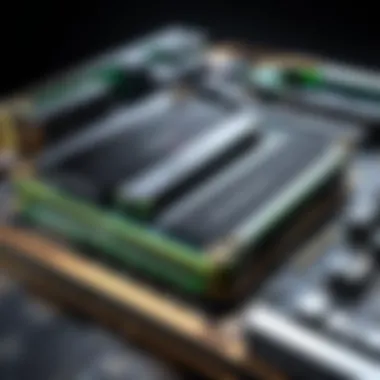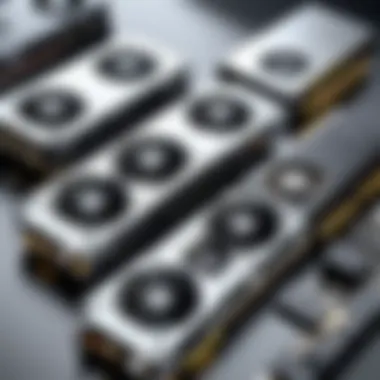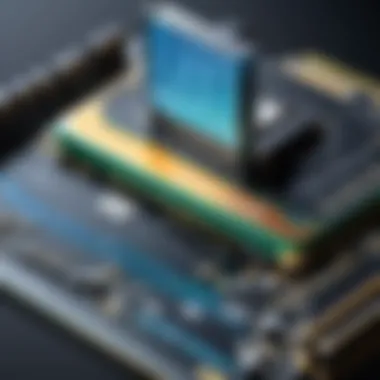Top Budget GPUs for Deep Learning in 2020


Intro
In the field of deep learning, the role of the GPU cannot be overstated. These specialized hardware components accelerate computation, enabling the training of complex algorithms and neural networks. In 2020, several budget GPUs emerged as viable options that deliver commendable performance without straining one’s finances. This guide examines the best budget GPUs for deep learning applications, exploring their specifications, performance benchmarks, and overall suitability for various projects.
Given the rapid evolution of technology, understanding the landscape of affordable graphics processing units is essential. This article not only highlights prominent models but also places emphasis on cost-effectiveness, making it relevant for enthusiasts and professionals alike. With a detailed analysis, tech aficionados can make informed choices tailored to their deep learning needs.
Prelude to Deep Learning and GPU Usage
Deep learning has established itself as a transformative field within artificial intelligence. It employs complex algorithms modeled after the human brain's architecture, enabling machines to recognize patterns with impressive accuracy. The significance of understanding deep learning is crucial, especially for those involved in technology and Esports. It not only shapes various applications, from image recognition to language processing, but influences the tools and hardware used in these processes.
Understanding Deep Learning
At its core, deep learning relies on artificial neural networks to simulate human cognitive functions. A deep learning model takes inputs, processes them through multiple layers of nodes—each representing a transformation—and finally produces an output. These processes are computationally intense and require substantial hardware resources. The advancements made in deep learning are largely aided by the evolution of GPUs, which excel at managing parallel computing tasks. As a result, many professionals and enthusiasts are keen to learn about the intricacies and capabilities of deep learning systems.
Role of GPU in Deep Learning
Graphics processing units (GPUs) have become essential in the deep learning landscape. Unlike traditional CPUs that perform one task at a time, GPUs can handle multiple tasks simultaneously, making them highly efficient for training deep learning models. This parallelism allows for faster processing of large datasets, which is critical when refining complex models. The combination of performance and cost ultimately dictates the choice of GPUs, making it an important factor for anyone looking to delve into deep learning.
"The use of GPUs in deep learning accelerates model training times dramatically, allowing researchers to experiment and innovate more rapidly."
In summary, understanding the interplay between deep learning and GPU technology is foundational for tech enthusiasts and professionals. This knowledge sets the stage for selecting the right hardware solutions, optimizing performance, and making informed decisions in deep learning projects.
Key Considerations for Choosing a GPU
Choosing the right graphic processing unit (GPU) is crucial for deep learning efficiency. This choice impacts not just performance but also the overall capability of your machine learning models. A suitable GPU can significantly reduce training time and improve the speed of inference. This section will explore the essential elements that contribute to informed GPU selection. Evaluating performance metrics, cost-effectiveness, and power requirements ensures that tech enthusiasts and professionals can identify GPUs that meet their specific needs without overspending.
Performance Metrics
Performance metrics are a way to gauge how well a GPU will perform in deep learning tasks. Understanding these metrics ensures that you make a selection that will offer the best value for your projects. The three critical aspects to consider include CUDA Cores, Memory Bandwidth, and VRAM Capacity.
CUDA Cores
CUDA Cores are parallel processors found in NVIDIA GPUs. They are essential for executing deep learning computations effectively. More CUDA Cores can mean greater parallel processing capability, which is vital for handling large datasets and complex models. A high count of CUDA Cores can enhance training times and improve computational throughput.
The key characteristic of CUDA Cores is how they handle tasks simultaneously. This makes them a favorable choice for deep learning, where many operations can occur at once. However, it's essential to consider that higher core counts must be matched with other specifications for optimal performance. The advantage of CUDA Cores lies in their scalability; they can fit well into various system configurations, though they may also increase power consumption in some cases.
Memory Bandwidth
Memory Bandwidth measures how quickly data can be read from or written to memory. In deep learning, faster memory access is crucial for moving large volumes of data during training and inference stages. High memory bandwidth is beneficial because it reduces bottlenecks when the GPU communicates with system memory.
The unique feature of Memory Bandwidth is that it directly affects the performance of tensor processing, a critical operation in deep learning. A GPU with high memory bandwidth ensures that models can run more efficiently. However, it is essential to balance this with VRAM capacity since bandwidth alone does not define overall performance.
VRAM Capacity
VRAM (Video RAM) capacity is vital for loading and processing large datasets. In deep learning applications, particularly with models like convolutional neural networks, having sufficient VRAM can prevent memory overflows. This capacity allows for more extensive datasets, improved model complexity, and better batch sizes during training.
The key characteristic of VRAM is its influence on the ability to work with large-scale applications. A higher capacity allows users to experiment with complex models without needing to constantly offload data. However, while large VRAM is a significant advantage, cost and integration with the rest of the system should also be considered to avoid overpaying for specifications that exceed practical needs.
Cost-Effectiveness
Cost-effectiveness pertains to the overall value a GPU presents for its price. It is essential to compare prices against performance levels to understand which options provide the highest return on investment. A cost-effective GPU offers solid performance without stretching budgets beyond comfortable limits.
Many users will find great value in cards that may not be the highest-end models but still perform well for deep learning tasks. Identifying the balance between performance and price is crucial, especially for those just starting in deep learning. Opting for GPUs that deliver substantial computational ability without excessive costs can yield better long-term results.
Power Requirements
Understanding power requirements is critical when selecting a GPU. Different models have varying power consumption rates, which can affect overall system performance and efficiency. GPU power consumption must be considered in the context of other components in the system. If a GPU requires too much power, it may lead to overheating or necessitate upgrades to other parts of the system, such as the power supply unit.
A beneficial aspect of lower power requirements is that they can increase system stability and reduce energy costs over time. GPUs that provide great performance without significantly taxing power resources offer long-term benefits. However, users must ensure that their entire configuration can support the GPU to prevent compatibility issues.
Choosing the right GPU based on these considerations will pave the way for effective deep learning tasks. The right balance ensures performance aligns with project needs while staying within budgetary constraints.
Budget GPUs Overview for
The selection of budget GPUs in 2020 highlights a critical aspect of deep learning projects. These graphic processing units provide sufficient power to handle various tasks without imposing a heavy financial burden. It is essential to consider the balance between cost and performance, as deep learning often demands significant computational resources.


When evaluating GPU options, several specific elements come into play, including specifications, architecture, and supported technologies. Each of these considerations plays a vital role in the performance of deep learning models. A good budget GPU is not only affordable but also allows for effective training and inference of complex neural networks.
As we present an overview of various budget GPUs available in 2020, we will delve into key performance metrics, user experiences, and reliability. This information will empower tech enthusiasts and professionals to make informed purchasing decisions based on both their specific needs and the technological trends of the year. Understanding these budget GPUs is pivotal for those seeking to optimize their deep learning workflows without overspending.
NVIDIA GeForce GTX Super
Specifications
The GTX 1660 Super features 1408 CUDA cores, which significantly contribute to its processing capability. It provides a memory bandwidth of 192 GB/s and is equipped with 6 GB of GDDR6 VRAM, making it effective for graphic-intensive tasks. This GPU's architecture is built on Turing technology, but it lacks the ray tracing cores found in higher-end models.
The key characteristic of the GTX 1660 Super is its cost-to-performance ratio, making it an attractive choice for budget-conscious users. The use of GDDR6 memory enhances data transfer rates, which can be beneficial during model training.
However, while the performance is commendable, the absence of advanced features like real-time ray tracing might limit its appeal for certain graphic-intensive applications.
Performance Analysis
In performance analysis, the GTX 1660 Super has shown to handle entry-level deep learning tasks efficiently. It excels in frameworks such as TensorFlow and PyTorch. The architecture allows for faster training of smaller models, making it ideal for hobbyists and those beginning their deep learning journey.
Its capability to process simple models quickly can save users a considerable amount of time. However, it may struggle with more complex networks, potentially leading to slower training times compared to higher-end GPUs.
Pros and Cons
The advantages of the GTX 1660 Super include:
- Affordable price range
- Good performance for entry-level deep learning tasks
- Efficient power consumption
On the downside, its limitations include:
- Insufficient for more complex tasks
- Lacks real-time ray tracing capabilities
AMD Radeon RX
Specifications
The AMD Radeon RX 5700 has remarkable specifications, including 2304 stream processors, which enhance its computational ability. It offers a memory bandwidth of 448 GB/s with 8 GB of GDDR6 VRAM. The GPU is designed using RDNA architecture, which improves performance and efficiency.
One of the key features is its high memory bandwidth, allowing the processing of larger datasets more effectively. This makes the RX 5700 a solid choice for more demanding applications.
Performance Analysis
The performance of the RX 5700 in deep learning tasks is impressive, particularly for medium-sized datasets. It supports various frameworks efficiently, making it a versatile option for developers. Moreover, its architecture helps in managing more complex model training.
However, some users have noted that it might not perform as well in inference tasks compared to NVIDIA counterparts, primarily due to different driver optimizations.
Pros and Cons
Strengths of the RX 5700 include:
- Strong performance in training larger models
- High VRAM capacity
Weaknesses are:
- Driver issues affecting inference speed
- Higher power consumption than some alternatives
NVIDIA GeForce RTX
Specifications
The RTX 2060 features 1920 CUDA cores and 6 GB of GDDR6 VRAM with a bandwidth of 336 GB/s. This mix allows it to handle parallel processing effectively, which is vital for deep learning applications.
A distinct characteristic of the RTX 2060 is its ray tracing capabilities, which, while not necessary for deep learning, can enhance performance in graphics-heavy tasks.
Performance Analysis
The RTX 2060 performs well across various deep learning frameworks and is known for its ability to train more complex models. Users have reported a substantial reduction in training times compared to older models.
However, as it comes with features primarily targeted at gaming, it might not be the most efficient choice for users exclusively focused on deep learning.


Pros and Cons
Key advantages of the RTX 2060 are:
- Excellent performance in deep learning tasks
- Additional ray tracing functionality
Disadvantages include:
- Higher price point compared to similar models
- Not optimized strictly for deep learning
NVIDIA GeForce GTX
Specifications
The GTX 1650 houses 896 CUDA cores and is equipped with 4 GB of GDDR5 VRAM alongside 128 GB/s bandwidth. It is less powerful than its counterparts but offers a viable entry into the world of deep learning.
Its low cost makes it an appealing option for individuals starting out.
Performance Analysis
The GTX 1650 can manage basic deep learning tasks but may struggle with larger networks or datasets. While it is suitable for beginners, users may quickly outgrow it as their needs become more advanced.
Its performance is sufficient for light workloads, but users should be cautious about its limitations for larger applications.
Pros and Cons
Pros include:
- Inexpensive option for newcomers
- Sufficient for basic tasks
Cons involve:
- Limited VRAM capacity
- Not suited for advanced models
AMD Radeon RX XT
Specifications
The RX 5500 XT consists of 1408 stream processors, along with 4 GB or 8 GB of GDDR6 VRAM, and has a memory bandwidth of 224 GB/s. This GPU leverages RDNA architecture, offering improved performance in a compact design.
Its key advantage is flexibility in its VRAM options, allowing users to select a variant based on their specific requirements.
Performance Analysis
The RX 5500 XT performs adequately for entry-level deep learning tasks and works well with popular frameworks. It appeals to users looking for budget-friendly solutions without sacrificing too much in terms of performance.
However, its performance can falter under heavier workloads, leading to performance drops.
Pros and Cons
Highlights of the RX 5500 XT are:
- Good entry-level performance
- Customizable VRAM options
Limitations include:
- Struggles under demanding deep learning tasks
- Less support compared to NVIDIA cards in some frameworks
Choosing the right budget GPU is essential for balancing cost and performance in deep learning, enabling more users and enthusiasts to engage with this transformative technology.
Benchmark Comparisons
Benchmark comparisons are vital for evaluating the performance and suitability of budget GPUs for deep learning tasks. This segment looks into various metrics that reflect how effectively a GPU can handle deep learning workloads. Understanding these benchmarks provides clarity on which GPU models deliver the best results without exceeding budget constraints.
In any decision-making process regarding GPU purchases, it is critical to assess how each card performs with different workloads. This way, individuals can avoid overspending on features they may not need while ensuring adequate capabilities for their specific applications.
Testing Methodology


The methodology used for testing different GPUs is crucial. Setting up a controlled environment helps provide accurate results that can be replicated by others. Performance metrics typically include training times, model convergence rates, and usability across different deep learning frameworks.
Both synthetic benchmarks and real-world scenarios should be part of the methodology. Benchmarks like TensorFlow or PyTorch performance tests can showcase how GPUs manage neural network training and inference scenarios.
The configurations used in the benchmarks must be noted as well, including the specific model versions of the deep learning frameworks and the datasets. An informed methodology ensures clear comparisons among the GPUs tested.
Results Overview
Deep Learning Framework Compatibility
Compatibility with deep learning frameworks is a core aspect of GPU performance. Many developers rely on specific libraries like TensorFlow, Keras, and PyTorch to build models. The capability of a GPU to integrate seamlessly with these platforms greatly enhances its usability.
The key characteristic to look for is support for CUDA, especially for NVIDIA GPUs. CUDA allows effective parallel processing, which accelerates computation tasks. Therefore, the more a GPU can leverage these supported frameworks, the more viable it is for deep learning tasks.
A unique feature of deep learning framework compatibility is the presence of optimized libraries. For example, NVIDIA developed cuDNN, which is specifically designed for deep learning tasks. The use of such optimized libraries can substantially improve training performance. However, it’s important to note that incompatibility or limited support for certain frameworks can be a disadvantage for some GPUs.
Real-World Performance
Real-world performance refers to how well a GPU performs under typical usage conditions. It examines practical scenarios, such as training machine learning models and running inference on test datasets.
Key characteristic of this aspect is its relevance to actual user experiences. While synthetic benchmarks can show high performance, real-world results may vary due to factors like thermal throttling, power consumption, or memory management. Thus, understanding real-world performance gives a clearer picture of the GPU’s utility.
One unique feature of real-world performance evaluations is the diversity of tasks assessed. From training simple image classifiers to more complex models involving natural language processing, performance can greatly differ. Although some GPUs might excel in specific tasks, they may falter in others, which is a crucial consideration in evaluating overall GPU effectiveness for deep learning.
Finding the Right GPU for Your Needs
Choosing a graphics processing unit (GPU) tailored to your specific deep learning needs is crucial for achieving efficient performance and meaningful results. The landscape of deep learning is vast and diverse, requiring different GPU specifications depending on the complexity and size of the tasks at hand. This section examines critical elements, benefits, and considerations that guide you to identify the right GPU.
Assessing Your Workload
Type of Deep Learning Models
When discussing deep learning models, it becomes essential to classify them based on their structure and objectives. Common types include convolutional neural networks (CNNs), recurrent neural networks (RNNs), and generative adversarial networks (GANs). Each model type has distinct characteristics that impact GPU requirements.
For instance, CNNs are prevalent in image processing tasks. They leverage intricate multiple layers to capture spatial hierarchies in images. This model type demands higher performance capabilities from the GPU, particularly in parallel processing. On the other hand, RNNs, useful for sequential data such as time series analysis, have different GPU needs as they rely more on recurrent calculations.
Selecting a GPU that aligns with the model type you are working with ensures efficiency and speed. A mismatch can lead to suboptimal performance and increased training times, which can be a limiting factor in experiments and results.
Unique Features and Benefits
- CNNs: Best for image-heavy tasks, combining speed and accuracy.
- RNNs: Excels in sequences but require more memory management.
Each model type brings advantages and disadvantages that impact your selection of a GPU based on your specific projects.
Data Size and Complexity
In deep learning, the size and complexity of your data can fundamentally influence the GPU choice. Larger datasets necessitate GPUs with substantial memory and faster data transfer rates. Complex data often consists of high-dimensional features that can add processing overhead, making your GPU selection vital to manage these challenges effectively.
One key characteristic of data complexity is dimensionality. As data gets more complicated, the processing requirements increase. A high capacity of VRAM in your GPU helps to feed these intricate models quickly. Furthermore, understanding your data's nature allows for better tailoring of your hardware choices.
Unique Features and Benefits
- Large Datasets: Require GPUs with high VRAM and memory bandwidth for efficiency.
- High-Dimensional Data: Improves the performance in tasks such as natural language processing or complex simulations.
In this section, understanding both workload characteristics helps form the basis of your GPU selection.
Future-Proofing Your Selection
Future-proofing is about anticipating advancements in your field. The rate of progress in deep learning can lead to constantly evolving requirements. Selecting a GPU that can accommodate potential growth in your projects means investing wisely. A balance between current needs and future scalability can avoid premature upgrades or compatibility issues later.
Consider GPUs that support newer architectures and technologies. Features like Tensor Cores on NVIDIA models offer enhancements in deep learning tasks, which might become standard as you develop more advanced models.
End
The conclusion of this article serves as a critical component in understanding the landscape of budget GPUs tailored for deep learning in 2020. In this section, we emphasize several specific elements vital for making informed decisions. It is essential to consider not only the performance metrics but also the overall value these GPUs provide considering their price.
Deep learning tasks demand reliable and efficient hardware. Budget GPUs can offer significant capabilities at a fraction of higher-end options. By summarizing the findings presented in previous sections, we encapsulate our analysis, ensuring that readers grasp how each GPU holds up under different scenarios. Key factors such as CUDA cores, memory bandwidth, and VRAM capacity come into play when determining which GPU can effectively handle specific workloads, particularly in deep learning.
Additionally, the behavior of each GPU within real-world applications cannot be overstated. Evaluating actual performance and compatibility across various deep learning frameworks gives readers a clearer understanding of what they can expect when integrating these GPUs into their projects.
"Investing wisely in the right GPU can enhance deep learning projects significantly, making advanced technology accessible without draining financial resources."
The considerations around future-proofing also emerge as a significant theme. With deep learning evolving rapidly, GPU selections must not just address current needs but also adapt to emerging technologies and methods. Cost-effectiveness does not only relate to the sticker price but encompasses the longevity and functionality of the hardware.



